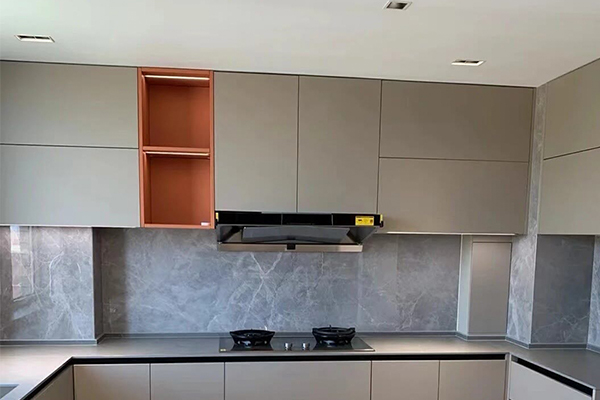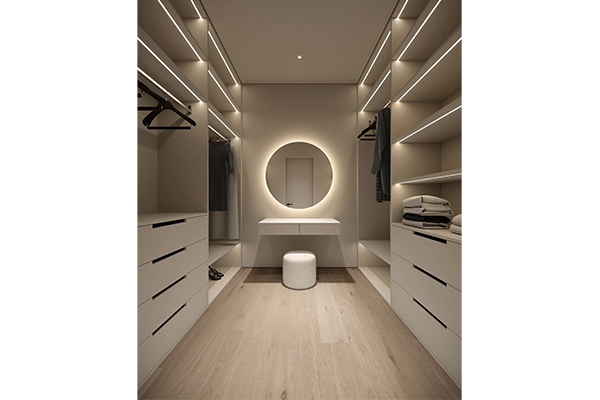How can a custom wardrobe achieve a personalized design based on the owner's height, habits, and clothing preferences?
Release Time : 2025-08-18
The core value of a custom wardrobe lies not in its glamorous appearance or complex structure, but in its ability to truly understand the user's life. Everyone's height, living habits, dressing style, and even collection preferences vary, and standardized, off-the-shelf wardrobes often fail to meet these subtle yet crucial needs. The significance of a custom wardrobe lies in precisely matching space and functionality with individual behavior through personalized design, creating a unique "customer-specific design" experience.
Height is the primary factor determining the interior layout of a wardrobe. Tall people often need to stand on tiptoe or even use tools to access items at height, while shorter people struggle to reach overhead. Custom wardrobes measure the owner's natural standing height and arm reach to strategically define the vertical placement of hanging areas. Frequently worn coats, shirts, and dresses are hung at arm's length, eliminating the need for excessive bending or lifting. Seasonal clothing and rarely used luggage are placed at the top, saving space and preventing disruption to daily use. For children or the elderly, the wardrobe's center of gravity shifts downward, ensuring all areas are within safe and comfortable reach.
Usage is the essence of design. Some people organize their clothing by color, others by occasion, and still others need numerous drawers for accessories, underwear, or folded clothing. Custom wardrobes can be flexibly configured to suit these preferences, with drawers, dividers, tie racks, trouser racks, jewelry racks, and other modules. Those who prefer hanging clothes can add a long coat area and double-layer hanging rails; those who frequently wear suits can create a separate hanging area for trousers and wrinkle-free storage for shirts; and those who ardently exercise can designate dedicated areas for sportswear, sneakers, and fitness gear. Every detail responds to lifestyle.
Clothing type directly influences storage options. Heavy coats and long skirts require ample vertical space to prevent wrinkles, while sweaters, which tend to lose their shape when hung for long periods, are better suited to being folded and stored in breathable drawers. Custom wardrobes will optimally allocate hanging, folding, and stacking areas based on the owner's wardrobe layout. For example, women may own more dresses and high heels, so the design might emphasize the long clothing area and the shoe compartment at the bottom. Men, on the other hand, might prefer shirt dividers and tie storage. Even small items like scarves, hats, and belts can be organized with built-in hooks or rotating racks.
Furthermore, the opening method varies depending on individual needs. Those with limited mobility prefer sliding doors, which save space in front of the door; those who seek a sense of formality prefer the expansive views offered by bifold doors. The opening angle of wardrobe doors, the damping of drawer rails, and the location of light sensors can all be fine-tuned to suit user habits. For example, upon waking up at night, a simple pull of the drawer illuminates a soft light, minimizing the risk of disturbing roommates.
In terms of space utilization, custom wardrobes can perfectly fit the wall structure, transforming "dead corners" into practical areas, whether in sloping ceilings, corners, or built-in spaces. Corners can be equipped with rotating hangers or interlocking drawers, ensuring efficient use of every inch. At the same time, the choice of materials, colors, and textures aligns with the homeowner's aesthetic preferences, making the wardrobe more than just a storage tool; it becomes an extension of the bedroom's style.
More importantly, a custom wardrobe is adaptable. As life stages, needs change. While clothing in youth is often fashion-forward, it transitions to business attire in middle age. Custom systems adapt to this evolution through modular replacement. Wardrobes in children's rooms can adjust in height as children grow, meeting the needs of different age groups.
Ultimately, a custom wardrobe is more than just a storage container; it reflects life. It doesn't force people to adapt to the space; it allows the space to serve them. From the hanging height of a coat to the placement of a scarf, every design detail subtly responds to the homeowner's daily rhythms and personal preferences. It's this deep connection that elevates a wardrobe from a cold, impersonal piece of furniture to a life partner that understands, protects, and accompanies them.
Height is the primary factor determining the interior layout of a wardrobe. Tall people often need to stand on tiptoe or even use tools to access items at height, while shorter people struggle to reach overhead. Custom wardrobes measure the owner's natural standing height and arm reach to strategically define the vertical placement of hanging areas. Frequently worn coats, shirts, and dresses are hung at arm's length, eliminating the need for excessive bending or lifting. Seasonal clothing and rarely used luggage are placed at the top, saving space and preventing disruption to daily use. For children or the elderly, the wardrobe's center of gravity shifts downward, ensuring all areas are within safe and comfortable reach.
Usage is the essence of design. Some people organize their clothing by color, others by occasion, and still others need numerous drawers for accessories, underwear, or folded clothing. Custom wardrobes can be flexibly configured to suit these preferences, with drawers, dividers, tie racks, trouser racks, jewelry racks, and other modules. Those who prefer hanging clothes can add a long coat area and double-layer hanging rails; those who frequently wear suits can create a separate hanging area for trousers and wrinkle-free storage for shirts; and those who ardently exercise can designate dedicated areas for sportswear, sneakers, and fitness gear. Every detail responds to lifestyle.
Clothing type directly influences storage options. Heavy coats and long skirts require ample vertical space to prevent wrinkles, while sweaters, which tend to lose their shape when hung for long periods, are better suited to being folded and stored in breathable drawers. Custom wardrobes will optimally allocate hanging, folding, and stacking areas based on the owner's wardrobe layout. For example, women may own more dresses and high heels, so the design might emphasize the long clothing area and the shoe compartment at the bottom. Men, on the other hand, might prefer shirt dividers and tie storage. Even small items like scarves, hats, and belts can be organized with built-in hooks or rotating racks.
Furthermore, the opening method varies depending on individual needs. Those with limited mobility prefer sliding doors, which save space in front of the door; those who seek a sense of formality prefer the expansive views offered by bifold doors. The opening angle of wardrobe doors, the damping of drawer rails, and the location of light sensors can all be fine-tuned to suit user habits. For example, upon waking up at night, a simple pull of the drawer illuminates a soft light, minimizing the risk of disturbing roommates.
In terms of space utilization, custom wardrobes can perfectly fit the wall structure, transforming "dead corners" into practical areas, whether in sloping ceilings, corners, or built-in spaces. Corners can be equipped with rotating hangers or interlocking drawers, ensuring efficient use of every inch. At the same time, the choice of materials, colors, and textures aligns with the homeowner's aesthetic preferences, making the wardrobe more than just a storage tool; it becomes an extension of the bedroom's style.
More importantly, a custom wardrobe is adaptable. As life stages, needs change. While clothing in youth is often fashion-forward, it transitions to business attire in middle age. Custom systems adapt to this evolution through modular replacement. Wardrobes in children's rooms can adjust in height as children grow, meeting the needs of different age groups.
Ultimately, a custom wardrobe is more than just a storage container; it reflects life. It doesn't force people to adapt to the space; it allows the space to serve them. From the hanging height of a coat to the placement of a scarf, every design detail subtly responds to the homeowner's daily rhythms and personal preferences. It's this deep connection that elevates a wardrobe from a cold, impersonal piece of furniture to a life partner that understands, protects, and accompanies them.







